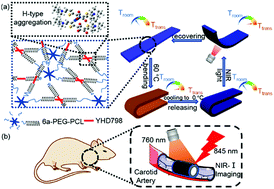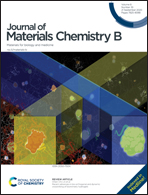A near-infrared light-triggered shape-memory polymer for long-time fluorescence imaging in deep tissues†
Abstract
Implanting a stent in the body through a minimally invasive operation and tracking its location in real-time is still a challenge. Herein, a near-infrared (NIR) light-triggered shape-memory polymer possessing a long-time fluorescence imaging function has been developed by cross-linking 6-arm poly(ethylene glycol)–poly(ε-caprolactone) using a croconate dye YHD798 as the chemical crosslinker and NIR-absorption perssad. Due to the extraordinary photothermal conversion property of YHD798, the temperature of the material raised from 20 °C to 120 °C under 808 nm near-infrared irradiation at 0.4 W cm−2, leading to shape recovery in 50 s in a programmed shape-transition process. YHD798 also exerted an aggregation-induced emission effect, endowing the polymer with a clear NIR fluorescence imaging function even when covered by a 2 mm pork slab and could be used for the real-time visualization of the implanted device fabricated from this polymer in deep tissues of the body. When a tubular stent that was fabricated from this polymer, was implanted into the carotid artery of a Sprague-Dawley rat, it could recover to its permanent shape under 808 nm laser irradiation in 60 s owing to the shape-memory function and facilitated NIR-I fluorescence imaging after implantation for a week owing to the croconate dye. This work provides a new strategy for designing and developing smart polymers with NIR-light-triggered shape-memory effect and long-term fluorescence imaging function for biomedical applications.



 Please wait while we load your content...
Please wait while we load your content...